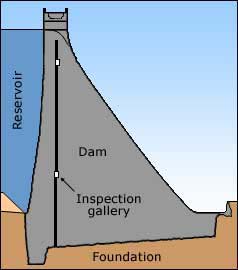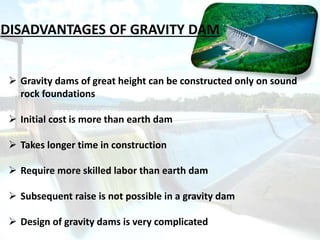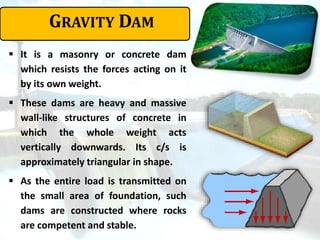What Best Describes a Gravity Dam
A gravity dam is a structure that is designed to absorb stresses by its own weight and resistance to sliding and overturning on its base. All other forces are not of much significance and are considered only under specific conditions.
The most ancient gravity dam on record was built in Egypt more than 400 years BC.

. In two dimensional analysis of the gravity dam unit length of the dam is considered. Answer 1 of 9. Although the weight of dam also helps in resisting the forces the structural behaviour of earthen dam is entirely different from that of gravity dam.
The dam serves as the backbone of a gravity-powered plant by supplying water for power generation while controlling flooding. A gravity dam is a dam constructed from concrete or stone masonry and designed to hold back water by primarily utilizing the weight of the material alone to resist the horizontal pressure of water pushing against it. Foremost among the worlds gravity dams is the 285-meter-high 935-foot-high Grande Dixence in.
The weight of the dam body and its foundation is the major resisting force. A gravity dam is a massive sized dam fabricated from concrete or stone masonry. Gravity Dams Forces Acting on Gravity Dam The Various external forces acting on Gravity dam may be.
By using concrete the weight of the dam is actually able to resist the horizontal thrust of water pushing against it. Require less material than any other type of dam Best in narrow rocky canyons Horizontal load is transferred to the abutments. A gravity dam is designed in such a way that it resists all external forces acting on the dam like water pressure wind pressure wave pressure ice pressure uplift pressure by its own self-weight.
It is the resting force that resists all the external forces acting upon the dam. However it may also be slightly curved in plan. A curved gravity dam resists the external forces by its weight and not by arch action.
Failure of gravity dam occurs due to overturning sliding tension and compression. This force acts linearly along the length of the dam and at the reservoir level. Gravity dams are designed so that each section of the dam is stable and independent of any other dam section.
Newer dams of this sort are often made of unreinforced concrete monoliths with joints sealed with seals. Gravity dam definition a dam resisting the pressure of impounded water through its own weight. A gravity dam is mostly straight in plan and is known as straight gravity dam.
Provided within the dam th e drain effectiveness and uplif t assumptions should follow the guidance provided in paragraph 3- 243 below and should be veri fied by instrumentation. Can be constructed using concrete. An earthen dam is made of earth or soil.
Gravity dams arch dam Buttress dam etc. Weight of the Dam. A gravity dam is a dam constructed from concrete or stone masonry and designed to hold back water by using only the weight of the material and its resistance against the foundation to oppose the horizontal pressure of water pushing against it.
Water Pressure Uplift Pressure Pressure due to Earthquake forces Silt Pressure Wave Pressure Ice Pressure The stabilizing force is the weight of the dam itself. It resists the forces exerted upon it mainly due to shear strength of soil. The dam axis of a gravity dam is a straight line so that the expansive deformation only brings compressive stress and we need not worry about overexpansionWhile the dam axis of an arch dam is a curve either temperature rise or drop.
Weight of the Dam. Timber dams are suitable up to 9 meters height. It can be calculated by.
Answer 1 of 4. Agravity dam can be defined as a can be solid concrete or masonry structure constructed across a river to create a reservoir on its upstream and it is designed to hold water back by using only the weight of the used material and the dams resistance against the foundation to oppose the horizontal pressure of water p. A Effect of top width added at the apex of triangular profile.
Self Weight of Dam. It is the most important force particularly for gravity dams. 3-243 Rock Foundations In the case of gravity Dams on rock founda tions a failure plane shall be assumed between the dam and the foundation.
Requires 13 to 12 as much concrete as gravity dams of similar height Used on foundations too weak to support a gravity dam Buttresses - load bearing supporting members. Newer dams of this type are typically composed of unreinforced concrete monoliths with seals at the joints. Gravity dams are constructed from masonry or concrete.
ABC is an elementary profile of the dam. The preliminary design of gravity dams is done by two dimensional gravity method by considering the dam as being made of a number of cantilevers of unit length and acting independently of adjacent cantilevers. A gravity dam is a structure designed to withstand loads by its own weight and by its resistance to sliding and overturning on its foundation.
They are designed to hold back large volumes of water. In an upcoming post we will see the design analysis of Gravity Dam where we can use the above-mentioned formula in detail. Most basic load Dead Load pressure.
Timber dams generally used for temporary purposes such as to divert the water for the construction of main dam to control flood water flow etc. Where Υ m unit weight of dam materials. The magnitude of this force varies from 250- 1500 knm².
Noun a dam so proportioned that it will resist overturning and sliding forces by its own weight. W Υ m Volume. Arch dam and gravity dam have the following differences in the dam construction technology with MgO concrete.
Out of above eight forces acting on the dam first three forces are the major forces that are considered in the design.



No comments for "What Best Describes a Gravity Dam"
Post a Comment